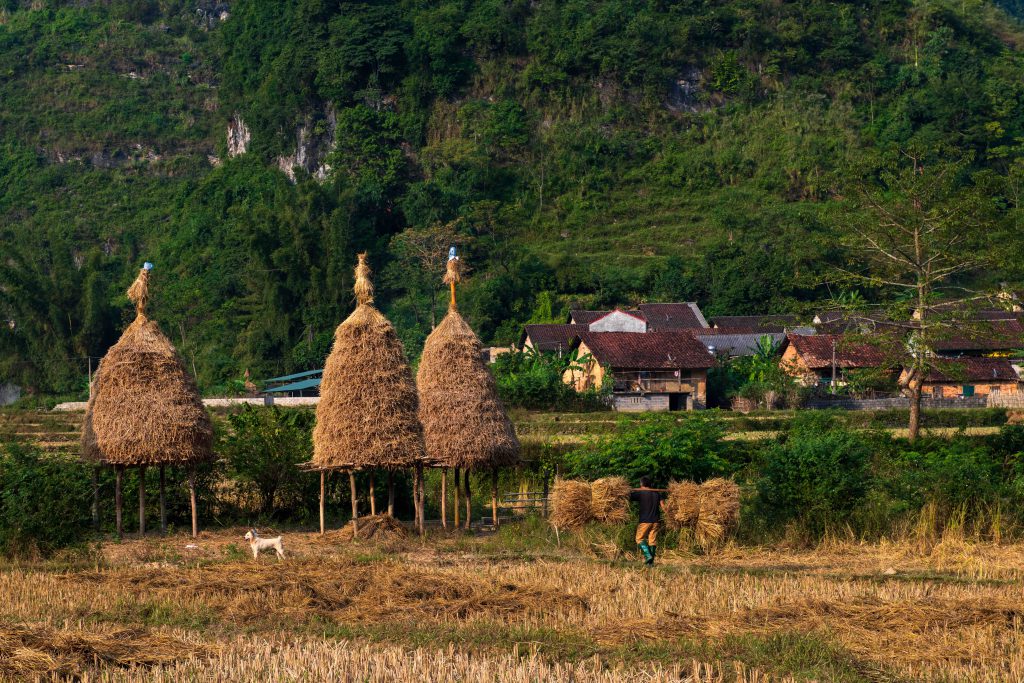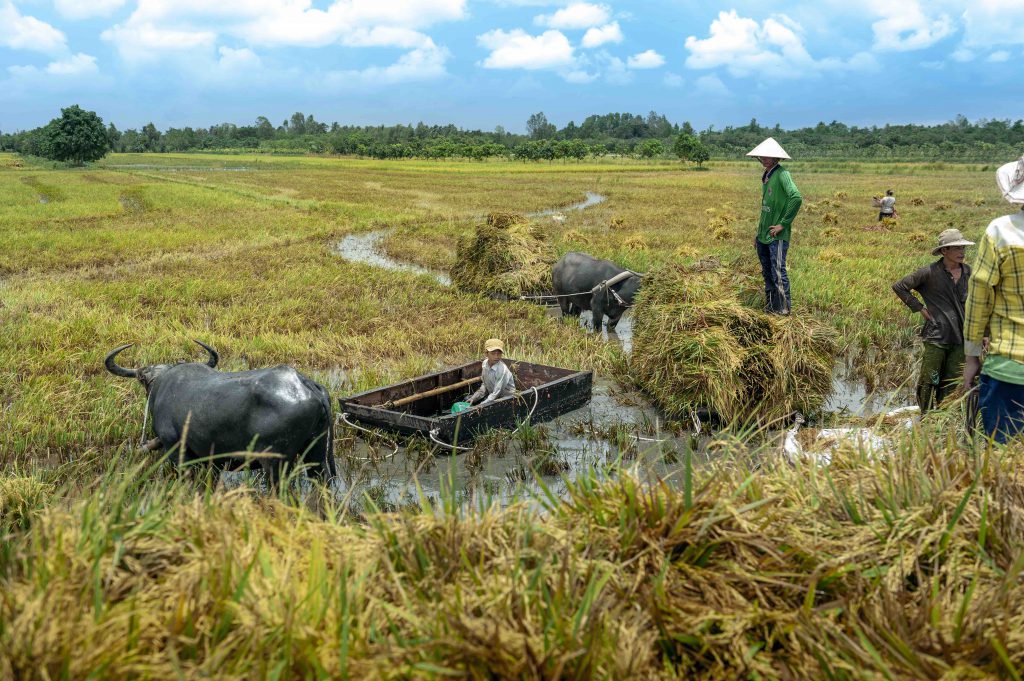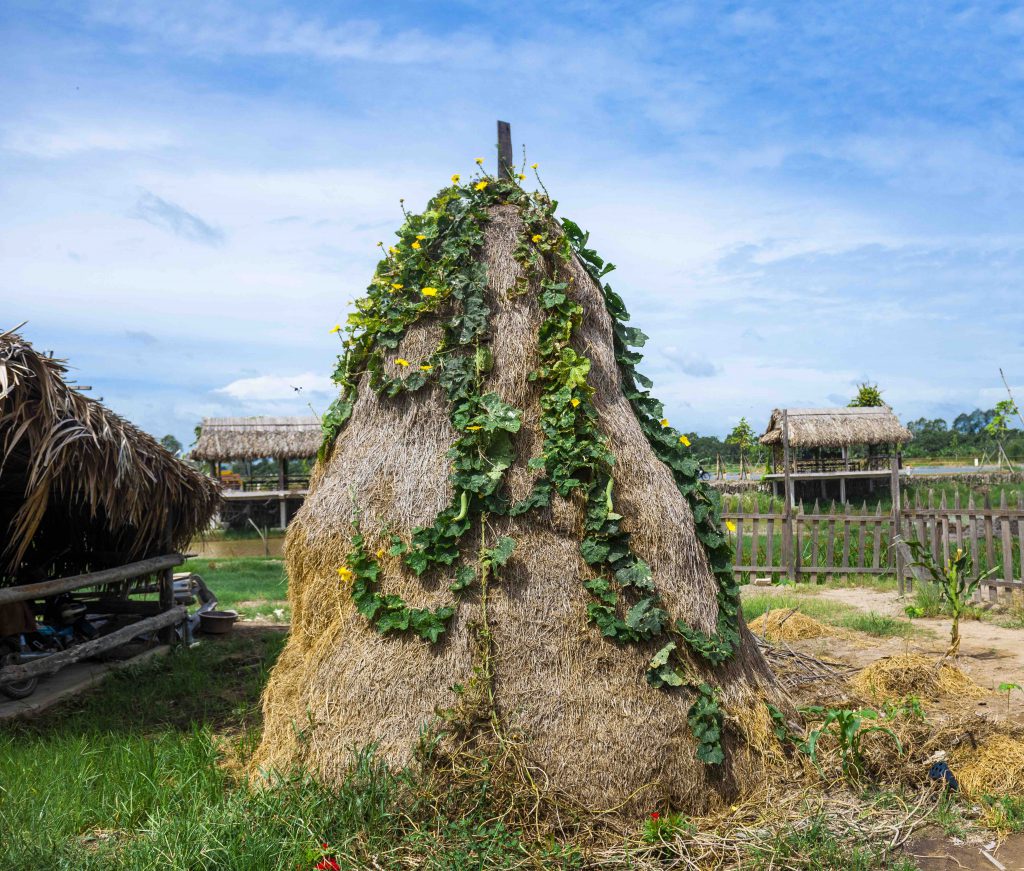Story: Truong Quy
Photos: Pham Quoc Dung, Ba Ngoc
For generations, the image of a straw stack in every yard has been a familiar sight in villages across Vietnam. Large stacks are called cây rơm and small piles are called đống rơm. After the rice grains are stored, the remaining rice stalks are piled in stacks to serve as fuel, bedding material, livestock feed, and even building materials. With its round, mushroom-like shape, a straw stack is renewed every harvest season. It not only serves as a versatile resource but also shelters the soul of the home.

The fragrant straw holds the essence of youth
From a young age, preschool children learn the song Bé quét nhà – (Sweeping song) by Ha Duc Hau, singing, “One strand of golden straw, two strands of golden straw, grandma makes a big broom, grandma makes a small broom…”
Golden rice straw has many uses in daily life, from being used to fashion brooms to tying up food packages. During difficult times, poor families relied on straw to stay warm and used straw to make cozy beds that witnessed the joys and sorrows of childhood, as in the poem Cây tam cúc by Hoang Cam, which states: “The tam cúc cards have curved edges. Stealing straw from home to make a bed… The fragrant straw bed holds the essence of youth.” Meanwhile, in Nguyen Duy’s verse The Warmth of the Straw Bed, the bond between soldiers and villagers is celebrated in the lyrics, “Golden straw wraps me like a silkworm cocoon. I lie awake in the honeyed scent of the fields…” These verses embrace the beauty of straw in Vietnamese life.
The straw stack served as a playground for children, a meeting place for young lovers, and a symbol of Vietnamese resilience during wartime. To avoid shrapnel from American air raids, people crafted straw hats and raincoats for children to wear on their way to school. Straw was also used to make thatched roofs, mud walls, and lime-straw ceilings in colonial-era villas in Hanoi. It seems that almost every aspect of Vietnamese life involves straw. From keeping livestock warm in the freezing northern winters to providing organic fertilizer for fields and gardens, farmers rely heavily on straw stacks. A straw stack symbolizes abundance and prosperity, as a good rice harvest yields ample straw to create a large stack.

Straw serves as a fuel source for kitchen fires used to cook pots of rice or clay pots of braised fish, which are buried in straw ash to yield the best flavor. Straw ash also creates the legendary black hue that’s essential for creating Dong Ho woodblock prints. Glossy black lines on handmade do paper create a rustic yet bold style that has endured to this day. Even at the end of its life cycle, straw continues to enrich farmers’ spiritual lives.
No longer lonely, the bamboo grove and the straw stack
Today, straw stacks are becoming rarer as people switch to gas and electric stoves, but straw twine is still seen in the streets. During the green rice season, every Hanoian looks for fragrant green rice flakes wrapped in lush lotus leaves and tied with soft golden strings of straw, like a charming autumn gift from the northern fields. The scents of lotus leaves and straw infuse the aromatic green rice to create a delightful symphony of flavors from the fields. The recipes for bánh gio (ash cake) and several other rustic dishes involves sticky rice straw ashes. One of the tastiest types of mushroom is the straw mushroom. Rich in vitamins and amino acids, this fragrant, crunchy mushroom features prominently in the cuisines of tropical and humid countries like Vietnam.
In practical life, straw is indispensable. In spiritual life, it has become a metaphor in Vietnamese proverbs and folk sayings. To describe budding romance, there’s the saying: “Lửa gần rơm lâu ngày cũng bén” (Fire near straw will eventually ignite). In the fields, scarecrows ward off birds and animals. The ironic terms “anh hùng rơm” (straw hero) and “lửa rơm” (straw fire) refer to fleeting things. The straw stack in every home is a repository of cultural and traditional memories. Verses in textbooks remind the younger generation of the straw bundles used to keep fires burning: “They pass the flame to each home, from ember to straw firelighter” (Đất nước – Motherland by Nguyen Khoa Diem).

Throughout history, the straw stack has brought peace to rural life and the nation, softening the hardships of war. Những làng đi qua (The villages we passed) by Quang Dung states: “Bamboo groves and straw stacks are no longer lonely. Dry almond leaves crack under the footsteps of guerrilla fighters.”
Although many children today are familiar with factory-farmed chickens, poetry lessons still teach them about hens laying eggs in straw nests and straw stacks evoking smoky kitchens, with the nostalgic sounds of roosters crowing at noon.
Golden straw stacks are likened to trees without foliage that still cast protective shadows over rural lives. In today’s rural landscape, the straw stack is a museum of beautiful memories, embodying simplicity and resilience.










